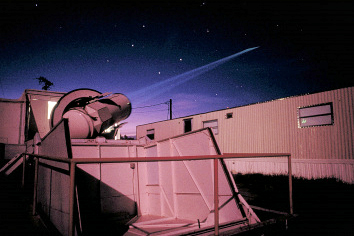Thanks to a new $4.25 million facility being built at UT’s McDonald Observatory, scientists will be able to more accurately describe tectonic plate movements and changes in the sea level.
The McDonald Geodetic Observatory focuses on geodesy, the study of the Earth’s shape and how it changes over time. This is the first observatory to be built and funded by NASA’s Space Geodesy Project and is expected to be in operation by 2022.
Taft Armandroff, director of McDonald Observatory, said the improved technology will help scientists better understand changes within the Earth’s crust.
“Because we know the speed of light so well and we can time things so accurately, we can get incredible distances,” Armandroff said. “We can create a reference frame. We can tell how the two sides of the San Andreas Fault are moving with respect to one another. We can tell incredibly precisely the height of the ocean …. We can tell if sea level increased by two inches exactly where that water would go.”
The project is part of a global network of observatories to improve the original International Terrestrial Reference Frame, which was built by NASA in the 1980s. The new observatories will use four different geodetic observation systems along with satellites to develop a reference frame of the planet. These systems use consistent records from specific points on Earth to contextualize changes in other places on the globe.
Stephen Merkowitz, director of NASA’s the Space Geodesy Project, said NASA’s research needs have exceeded the old reference frame system’s abilities.
“The current networks of those systems are decades old,” Merkowitz said. “They’re well past their designed lifetime … They’re not going to meet the future needs of NASA’s Earth science missions.”
UT’s Center for Space Research will run the observatory. The center is a research organization within the Cockrell School of Engineering that has worked with McDonald Observatory for decades on Earth science research.
The researchers at McDonald have kept a record of the site’s geodetic properties for nearly 50 years. Srinivas Bettadpur, director of the Center for Space Research, said this, along with the relatively geodetic stability of the surrounding area and its lack of earthquakes and consistent rainfall, made McDonald the key candidate for this new facility.
“In order to describe how the landmarks are changing over time, you have to have continuous observations,” Bettadpur said. “You have a site with a 50-year history of observation, so you don’t want to give that up. That’s part of the record of basically how the North American (tectonic) plate has moved over the past 50 years.”
Bettadpur said the new observatory is an opportunity for students to get involved with Earth science and understand how measuring local geographic changes affect the scientific community’s understanding of the Earth as a whole.
“It opens up a new front in research,” Bettadpur said. “It’s an outstanding opportunity for students to do some fieldwork and learn field techniques in geodesy and engineering. It’s (also) actually a great opportunity for students to see global concerns in highly localized actions … The student has to be able to see the connection between their own actions on a mundane day to the larger goals of (changes in) the sea level.”





















